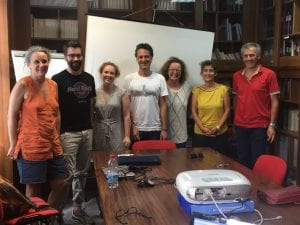Induced earthquakes – how and when they have occurred, and why should anyone care
By Joanna P Faure Walker, on 27 September 2018
Despite the high volume of material out there about induced earthquakes, it can be hard to separate fact from opinion. To help explain what induced seismicity is, how it is caused and what the risks are, a group of researchers from UCL Department of Chemical Engineering and Institute for Risk and Disaster Reduction have published “Addressing the risks of induced seismicity in subsurface energy operations”.
What causes “induced seismicity”? Induced earthquakes, those mainly caused by human action, can invoke strong feelings towards the processes that cause them, the most widely known among these is hydraulic fracturing (less favourably known as “fracking”). But hydraulic fracturing for shale gas extraction is not the only cause of induced earthquakes – several industrial activities are capable of inducing or triggering earthquakes, including mining, dams, conventional oil and gas operations, groundwater extraction, CO2 Capture and Storage (CCS), underground waste fluid disposal and the creation of geothermal energy systems. Rightly or wrongly, negative public perception and local public opposition to induced seismicity has led to numerous international projections having been suspended, delayed or curtailed.
How does industrial operation induce earthquakes? The Earth’s crust is believed to be in a state where it is critically stressed and only small stress changes in the right direction can cause an earthquake. Industrial action can alter the stress field in the most shallow part of the Earth’s crust, inducing a seismic event.
Are these events getting more likely? The number of documented cases of man-made earthquakes in different industrial activities is rapidly increasing: In 2017 alone, there were two reported record-breaking magnitude induced seismic events. One of the more well-known areas of induced seismicity is in the United States: The notable increase in seismicity within the last decade in the previously seismically quiet State of Oklahoma has been widely attributed to large scale waste water injection wells connected to the hydrocarbon production industry.
How big are induced earthquakes? Most induced earthquakes are low in magnitude (typically less than magnitude 4). However, even these small events are capable of causing structural damage to properties and evoking widespread fear and anxiety. We say most are small, but there are some examples where large magnitude earthquakes have been alleged to be caused by human activities. For example, in China in 2008, a dam was built that filled a reservoir behind it. A short time later, a magnitude 8 earthquake occurred in the region. Some scientists proposed this large earthquake was caused by the mass loading of the water in the dam and its penetration into rock, affecting the subsurface pressure in an underlying fault line and possibly setting off a series of ruptures that led to the earthquake.
So what is being done about it? Minimising seismic risk should be a high priority for industrial operators. All fluid injection processes should require detailed seismic hazard assessments for imaging and characterising faults prior to operations, with dedicated monitoring systems in addition to existing national seismic monitoring facilities. For assessing the risks, monitoring the operations, and designing mitigation strategies using predictive models that can characterise the spatiotemporal evolution of induced seismicity would be extremely helpful. Examples of best practice approaches show that maintaining a transparent dialogue between operator and the public, while adhering to the regulatory processes can allow safe operations in an atmosphere of public acceptance.
Where can I find out more? With all the controversy around such events, we need to understand what are the risks of induced earthquakes and how can we model them. In the published article in Wiley Interdisciplinary Reviews, Richard Porter, Alberto Atriolo, Haroun Mahgerefteh and Joanna Faure Walker provide a review of several alleged induced seismicity case studies that have occurred in the last 15 years covering a variety of causal mechanisms. We discuss issues relating to public perception and procedures and strategies that could be implemented to help prevent and mitigate future occurrences.
The above work was funded by Horizon 2020 research and innovation programme, Grant/Award Number: 640979
 Close
Close


